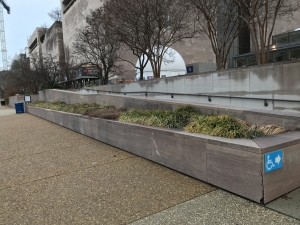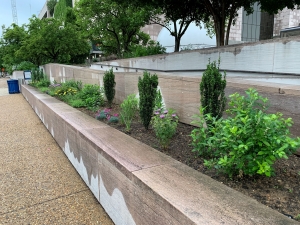Where can you find Rocket’s Red Glare, a Blue Moon, and a Neon Star? In a garden of course!
One of the many joys of working at a public garden is the ability to constantly change and improve the garden spaces. Often it is merely the addition or removal of a few plants here and there, but sometimes we get to enjoy completely renovating a space from the ground up. This spring at the National Air and Space Museum we had one such opportunity. Located on the south side of the building is a small bed with little “curb appeal” yet located in a highly visible spot. So, we decided this was the year to make a change!
But how did we get there? How did we start with a blank canvas and turn it into not only a beautiful garden, but also one that enabled Smithsonian Gardens to connect it to the themes of the museum?
 The first step was an easy one: identifying that this spot was in desperate need of a makeover. The bed is about 78 feet long and 4 feet wide and had been planted wall-to-wall with liriope and daylilies. Certainly, daylilies can add a splash of color for a moment in the summer, but since these were not reblooming daylilies, their contribution to the aesthetics of the bed were minimal. And while liriope might have its place as an evergreen groundcover, at Smithsonian Gardens we want to take every opportunity to showcase dynamic, interesting plants and garden designs. Neither of these plants really fit the bill as interesting or dynamic, not to mention they served very little ecological benefit.
The first step was an easy one: identifying that this spot was in desperate need of a makeover. The bed is about 78 feet long and 4 feet wide and had been planted wall-to-wall with liriope and daylilies. Certainly, daylilies can add a splash of color for a moment in the summer, but since these were not reblooming daylilies, their contribution to the aesthetics of the bed were minimal. And while liriope might have its place as an evergreen groundcover, at Smithsonian Gardens we want to take every opportunity to showcase dynamic, interesting plants and garden designs. Neither of these plants really fit the bill as interesting or dynamic, not to mention they served very little ecological benefit.
So, out with the old and in with the new! With the decision made to renovate this garden bed, it was on to designing how the garden would look once the liriope and daylilies were removed. The gardens around each of the Smithsonian museums are designed with a theme in mind that connects it to the overarching content of the adjacent museum. And I must admit, I do love a themed garden. This inspired me to design a garden with an air and space theme, one where almost all the plants have an air or space related cultivar name. I wanted visitors to start their visit to the museum before they even stepped inside to see the rockets, spacesuits, and Spirit of St. Louis. But in addition to plants with themed names (such as Monarda ‘Blue Moon’), I also wanted to highlight birds and pollinators (things that fly) and things that show movement in the wind (a key component of flight), all in support of a garden having multi-seasonal interest.
 Over the course of the winter months, I searched high and low in plant catalogs and internet sites for appropriately named plants. Luckily, many of the plants I discovered were also North American natives. This helped tie in the message of creating habitats for birds and pollinators. In a few instances I did go off-script to select plants that were the very best for our winged friends even if they did not have a themed name. Similar concessions were made for a handful of plants that contributed to multi-season interest, particularly during the winter. ended up with an extensive list of plants and, not surprisingly, had to cull it down to only the best of the best.
Over the course of the winter months, I searched high and low in plant catalogs and internet sites for appropriately named plants. Luckily, many of the plants I discovered were also North American natives. This helped tie in the message of creating habitats for birds and pollinators. In a few instances I did go off-script to select plants that were the very best for our winged friends even if they did not have a themed name. Similar concessions were made for a handful of plants that contributed to multi-season interest, particularly during the winter. ended up with an extensive list of plants and, not surprisingly, had to cull it down to only the best of the best.
After plants were selected, I finally started designing. I drew a scaled plan of the bed and began placing plants in repeated groupings for continuity, or evenly staggered to create a “backbone,” or tucked in spots as pops of color. This process underwent several iterations with feedback and input from my co-workers before landing on a final design. Which I might add was even tweaked a bit when it came time for planting.
 With a design in place, plants were ordered from wholesale and online vendors, and we began prepping the bed for the new plants. Since there are only two horticulturists assigned to care for the gardens around the Air and Space Museum, we organized a workday, and six co-workers from other gardens and landscapes at the Smithsonian came over and helped remove the liriope and daylilies by hand. What a huge help! And with that, the worst was behind us. A week or so later, plants arrived from the growers and we were able to install the brand-new design, instantly upgrading the garden bed from drab to fab! Final steps included adding a layer of mulch to suppress weeds and retain moisture, a few annuals for summer-long color, plant labels so everyone can see the fun names, and signage to share the garden theme with visitors.
With a design in place, plants were ordered from wholesale and online vendors, and we began prepping the bed for the new plants. Since there are only two horticulturists assigned to care for the gardens around the Air and Space Museum, we organized a workday, and six co-workers from other gardens and landscapes at the Smithsonian came over and helped remove the liriope and daylilies by hand. What a huge help! And with that, the worst was behind us. A week or so later, plants arrived from the growers and we were able to install the brand-new design, instantly upgrading the garden bed from drab to fab! Final steps included adding a layer of mulch to suppress weeds and retain moisture, a few annuals for summer-long color, plant labels so everyone can see the fun names, and signage to share the garden theme with visitors.
A s the months and years go by, I’m sure we will need to make small tweaks and changes (as with any garden!), but all in all this garden renovation has truly felt like a success. We hope if you’re visiting D.C. that you’ll take a stroll past this bed and enjoy the newest change to the gardens at the National Air and Space Museum! For those of you who are unable to visit in person, be sure to follow our social media accounts for highlights and updates on this garden. It’s out of this world!
s the months and years go by, I’m sure we will need to make small tweaks and changes (as with any garden!), but all in all this garden renovation has truly felt like a success. We hope if you’re visiting D.C. that you’ll take a stroll past this bed and enjoy the newest change to the gardens at the National Air and Space Museum! For those of you who are unable to visit in person, be sure to follow our social media accounts for highlights and updates on this garden. It’s out of this world!

